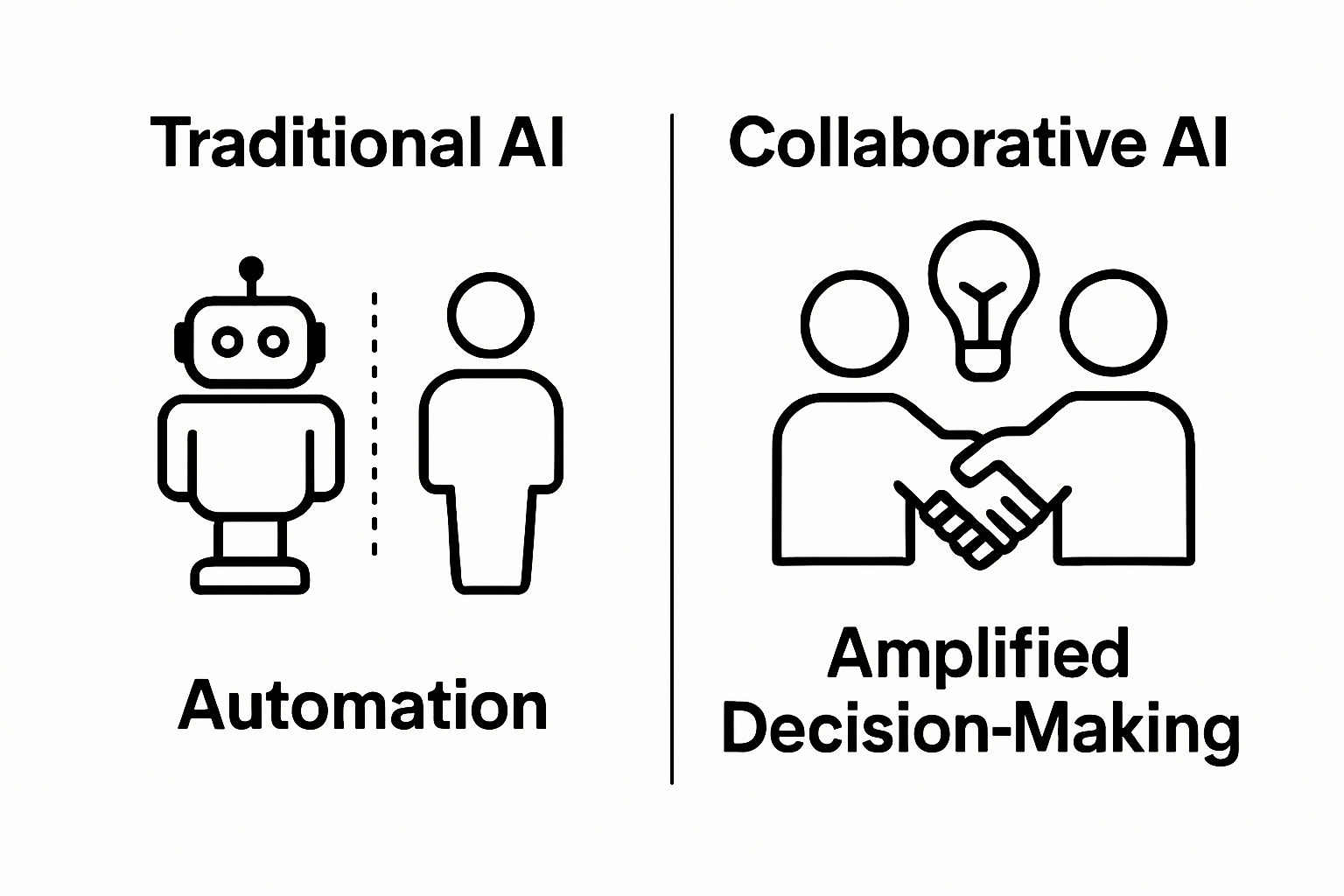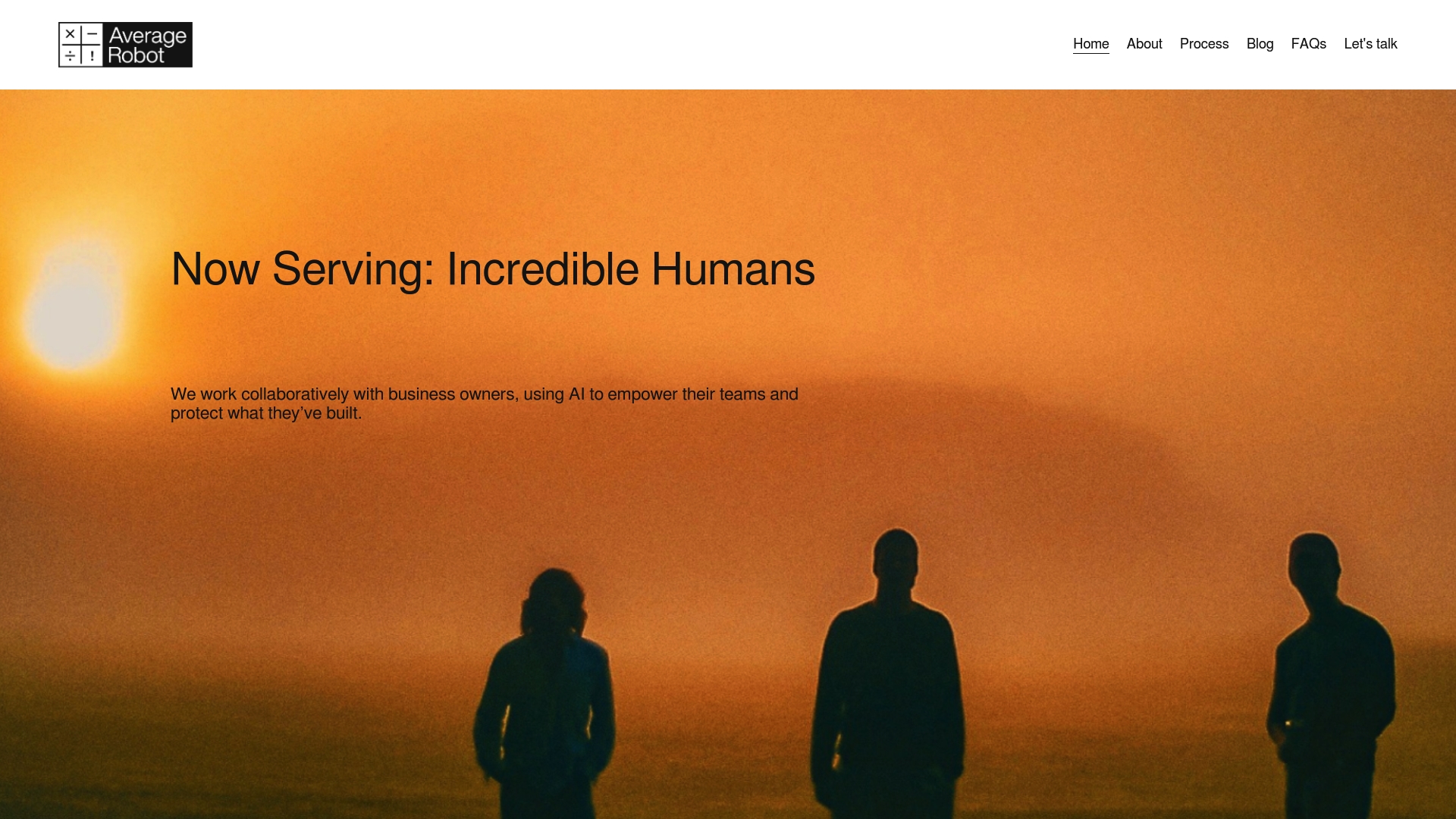Understanding Why Collaborative AI Matters for Business

Collaborative AI is reshaping how people and technology work together. Most think artificial intelligence means replacing jobs with machines, but that story is changing fast. Research shows that collaborative AI can increase productivity, accuracy, and decision-making speed in ways pure automation cannot. What surprises even industry veterans is that the real power comes not from machines taking over, but from humans and algorithms teaming up to solve problems nobody could tackle alone.
Table of Contents
- What Is Collaborative Ai And Its Importance?
- The Impact Of Collaborative Ai On Business Efficiency
- How Collaborative Ai Enhances Teamwork And Innovation
- Key Concepts Behind Collaborative Ai Technologies
- Real-World Applications Of Collaborative Ai In Various Sectors
Quick Summary
| Takeaway | Explanation |
|---|---|
| Collaborative AI empowers human expertise. | It enhances human decision-making without replacing it, fostering a partnership between humans and machines. |
| Improves operational efficiency in business. | Smart workflows enabled by AI streamline processes and reduce manual tasks, boosting productivity. |
| Enhances teamwork through better communication. | Collaborative AI reduces barriers, facilitating clearer exchanges of information and ideas among team members. |
| Fosters innovation by amplifying creativity. | By handling data-heavy tasks, AI allows teams to focus on creative problem solving and strategic thinking. |
| Real-world applications benefit multiple sectors. | Collaborative AI finds practical uses in healthcare and finance, enhancing outcomes and decision-making processes. |
What is Collaborative AI and Its Importance?
Collaborative AI represents a transformative approach to artificial intelligence where human expertise and technological capabilities work together seamlessly, creating solutions that are greater than the sum of their parts. Unlike traditional AI models that operate in isolation, collaborative AI integrates human judgment, creativity, and strategic thinking with machine learning algorithms to solve complex business challenges.
Below is a table summarizing the distinct features of traditional AI versus collaborative AI, clarifying how their approaches differ in business contexts.
| Approach | Human Role | AI Role | Decision-Making | Collaboration Level |
|---|---|---|---|---|
| Traditional AI | Minimal, oversight only | Automates tasks, replaces human effort | Primarily by AI | Low |
| Collaborative AI | Active partner, retains control | Assists and augments human capabilities | Shared (Human + AI) | High |
Understanding the Core Concept
At its foundation, collaborative AI is about empowering human teams rather than replacing them. This approach recognizes that while AI can process vast amounts of data and identify patterns quickly, humans bring critical contextual understanding, ethical considerations, and nuanced decision making skills. According to Carnegie Mellon University’s research, collaborative AI transforms how businesses approach problem solving by creating an integrated environment where technological capabilities enhance human intelligence.
Key characteristics of collaborative AI include:

- Augmenting human capabilities instead of attempting to replicate or replace them
- Providing real time insights and recommendations
- Enabling faster and more informed decision making
- Maintaining human oversight and control throughout the process
Business Value and Strategic Importance
For business owners, collaborative AI offers a strategic pathway to enhance operational efficiency while maintaining the unique value of human expertise. This approach allows companies to leverage AI technologies without losing the nuanced understanding that comes from years of industry experience. The goal is not automation for its own sake, but creating intelligent systems that work alongside human teams.
Businesses adopting collaborative AI can expect significant advantages. These include improved productivity, more accurate predictive analytics, and the ability to tackle increasingly complex challenges by combining machine processing power with human strategic thinking. The technology enables teams to focus on high value tasks while repetitive or data intensive work is managed efficiently by AI systems.
By prioritizing human control and strategic input, collaborative AI represents a responsible and intelligent approach to technological integration that respects both technological potential and human expertise.
The Impact of Collaborative AI on Business Efficiency
Collaborative AI has emerged as a powerful catalyst for transforming business efficiency, offering organizations unprecedented opportunities to optimize operations, accelerate decision making, and unlock strategic potential. By bridging the gap between technological capabilities and human expertise, these intelligent systems are redefining how businesses approach complex challenges and drive sustainable growth.
Operational Performance Enhancement
Businesses utilizing collaborative AI can dramatically improve their operational performance by creating intelligent workflows that seamlessly integrate machine learning with human strategic oversight. According to National Academies of Sciences research, these advanced systems enable organizations to streamline processes, reduce manual intervention, and allocate human resources more strategically.
Key efficiency gains include:
- Reducing time spent on repetitive administrative tasks
- Improving accuracy of data analysis and reporting
- Enabling faster and more informed decision making
- Creating adaptive workflows that respond dynamically to changing business conditions
Strategic Resource Allocation
Collaborative AI transforms how businesses deploy their most valuable resource: human talent. Instead of viewing technology as a replacement for workers, these systems create an environment where employees can focus on high value, creative tasks that require complex reasoning and emotional intelligence. By automating routine processes and providing real time insights, AI enables team members to concentrate on strategic initiatives that drive meaningful business growth.
This approach allows companies to maximize their human capital by redirecting skilled professionals from mundane tasks to innovative problem solving, strategic planning, and customer engagement. The result is not just increased efficiency, but a more engaged and motivated workforce that can respond more effectively to market challenges.
Ultimately, collaborative AI represents more than a technological upgrade it is a fundamental reimagining of how businesses can leverage intelligent systems to create more agile, responsive, and human centric organizations. By prioritizing collaboration between human expertise and machine capabilities, companies can build more resilient, adaptive, and competitive business models.
How Collaborative AI Enhances Teamwork and Innovation
Collaborative AI represents a revolutionary approach to team dynamics, transforming how professionals interact, solve problems, and generate innovative solutions. By integrating artificial intelligence with human creativity, organizations can unlock unprecedented levels of collective intelligence and organizational performance.
Breaking Down Communication Barriers
Traditional team collaboration often suffers from communication limitations, knowledge silos, and individual cognitive biases. Collaborative AI addresses these challenges by providing a neutral, data driven platform that facilitates more transparent and efficient information exchange. According to research from Procter & Gamble, AI systems can effectively bridge communication gaps, helping teams perform at higher levels by providing objective insights and recommendations.
Key communication enhancement features include:
- Real time translation and language support
- Objective analysis of team interaction patterns
- Identification of potential collaboration bottlenecks
- Suggestion of optimal communication strategies
Amplifying Creative Potential
Collaborative AI acts as an intelligent catalyst for innovation, transforming how teams generate and evaluate ideas. By processing vast amounts of information rapidly, AI can identify connections and patterns that human teams might overlook. This capability enables professionals to explore creative solutions more comprehensively, breaking free from traditional thinking constraints.
The technology supports innovation by:
- Generating diverse solution proposals
- Providing data driven feedback on idea feasibility
- Highlighting potential risks and opportunities
- Facilitating cross functional knowledge sharing
Moreover, collaborative AI does not replace human creativity but amplifies it. By handling complex computational tasks, AI frees team members to focus on high level strategic thinking, emotional intelligence, and complex problem solving. This symbiotic relationship between human intuition and machine intelligence creates a powerful framework for continuous organizational innovation.

Ultimately, collaborative AI represents more than a technological tool it is a paradigm shift in how teams conceptualize, develop, and implement groundbreaking ideas. By prioritizing human potential and providing intelligent support, these systems are redefining the boundaries of collective human achievement.
Key Concepts Behind Collaborative AI Technologies
Collaborative AI technologies represent a sophisticated fusion of advanced machine learning algorithms, human centered design principles, and adaptive systems that fundamentally reimagine technological interaction. By moving beyond traditional automation models, these technologies create intelligent environments where technological capabilities and human expertise work in concert to solve complex challenges.
Foundational Technological Architecture
Collaborative AI is built on a multilayered technological framework that integrates several critical components. According to MIT’s Scheller Teacher Education Program, these technologies are designed to facilitate nuanced, context aware interactions that go far beyond simple task completion.
Core technological components include:
- Advanced natural language processing systems
- Contextual machine learning algorithms
- Adaptive feedback mechanisms
- Real time data interpretation capabilities
- Dynamic interaction modeling
Human Centered Design Principles
The most sophisticated collaborative AI technologies prioritize human agency and experience. Unlike traditional AI systems that operate as standalone tools, these technologies are engineered to understand and anticipate human intentions, limitations, and potential. They function as intelligent partners that can interpret subtle contextual cues, provide meaningful recommendations, and adapt their responses based on ongoing interaction.
Key design principles emphasize:
- Transparency in algorithmic decision making
- Preserving human autonomy and control
- Creating intuitive interaction interfaces
- Developing ethical and responsible AI frameworks
By integrating advanced technological capabilities with deep understanding of human cognitive processes, collaborative AI represents a profound shift from viewing technology as a replacement to seeing it as an empowering collaborative tool. These technologies do not seek to supersede human intelligence but to amplify our collective problem solving potential, creating more intelligent, responsive, and adaptive organizational ecosystems.
Real-World Applications of Collaborative AI in Various Sectors
Collaborative AI is transforming industries by creating intelligent systems that enhance human capabilities and drive innovation across multiple sectors. These technologies are not just theoretical concepts but practical solutions that solve complex business challenges and create new opportunities for growth and efficiency.
Healthcare Transformation
Collaborative AI is revolutionizing medical diagnostics and patient care, offering unprecedented support to healthcare professionals. According to National Institutes of Health research, these intelligent systems provide critical support in complex medical scenarios by complementing human expertise with rapid data analysis and predictive capabilities.
Key healthcare applications include:
- Assisting radiologists in detecting early disease signs
- Supporting surgical planning with precision imaging analysis
- Predicting patient risk factors and treatment outcomes
- Streamlining administrative medical documentation
- Enhancing personalized treatment recommendations
Financial Services and Strategic Decision Making
In the financial sector, collaborative AI enables more sophisticated risk assessment, fraud detection, and investment strategies. These technologies analyze massive datasets faster and more accurately than traditional methods, providing financial professionals with nuanced insights that inform critical business decisions.
Financial institutions leverage collaborative AI for:
- Advanced credit risk modeling
- Real time fraud detection systems
- Personalized investment portfolio management
- Regulatory compliance monitoring
- Customer service automation with intelligent support
By integrating machine learning algorithms with human strategic oversight, collaborative AI creates a powerful ecosystem where technological capabilities amplify human intelligence.
The following table highlights key real-world applications of collaborative AI, mapping each sector to specific use cases outlined in the article for quick reference.
| Sector | Application Area | Example of Collaborative AI Use |
|---|---|---|
| Healthcare | Medical diagnostics and patient care | AI-assisted disease detection, personalized treatment |
| Financial Services | Risk assessment and fraud detection | Real-time fraud alerts, credit risk modeling |
| Financial Services | Investment and compliance | Portfolio management, regulatory monitoring |
| Healthcare | Treatment planning and documentation | Surgical planning support, automating records |
Ready to See Collaborative AI in Action for Your Business?
You have seen how collaborative AI blends human expertise with powerful machine learning to solve real business problems. The article explained how the true value comes from integrating AI into your team, not just adopting it for automation. For mid-tier business owners, the biggest barriers are often complexity, communication gaps, and bridging technology with existing strategic goals. These pain points—like automating routine tasks while keeping your team motivated and making every innovation count—do not disappear on their own. They require hands-on guidance and real-world experience.

That is where Average Robot steps in as your trusted AI Council. Our approach puts your business at the center, giving you tailored roadmaps, proven playbooks, and change management tools that let your team maintain control while embracing efficiency. Ready to cut through the noise and set your company apart with smarter collaboration and faster innovation? Visit Average Robot’s homepage to start building an AI strategy that fits your business goals. Let us help you lead the next chapter in operational excellence—act now for a competitive edge before your competitors catch up.
Frequently Asked Questions
What is Collaborative AI?
Collaborative AI is a transformative approach that integrates human expertise with machine learning algorithms to create solutions that enhance decision-making and problem-solving in business.
How does Collaborative AI improve business efficiency?
Collaborative AI improves efficiency by automating repetitive tasks, providing real-time insights, and enabling faster decision-making, allowing human teams to focus on high-value tasks.
What are the benefits of using Collaborative AI for teamwork and innovation?
Collaborative AI enhances teamwork by breaking down communication barriers and amplifying creativity, allowing teams to generate innovative solutions and explore ideas more comprehensively.
Why is human oversight important in Collaborative AI?
Human oversight is crucial in Collaborative AI because it ensures ethical considerations are taken into account, provides contextual understanding, and maintains control over decision-making processes.
Recommended
- 5 Costly Mistakes Businesses Make When Implementing AI…What Successful Business Owners Do Differently. — Average Robot
- About | Discover Opportunities - Schedule Today — Average Robot
- Owner-Led AI Adoption Tips for Small Businesses — Average Robot
- About | Discover Opportunities - Schedule Today — Average Robot
- The Impact of AI on SEO in 2025: Key Changes for Businesses




